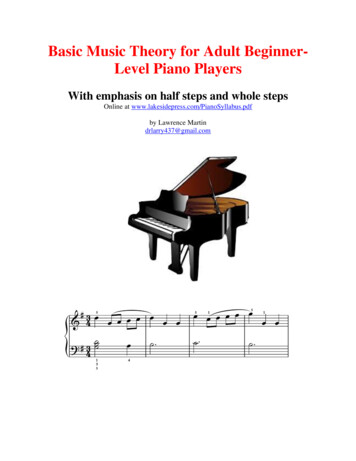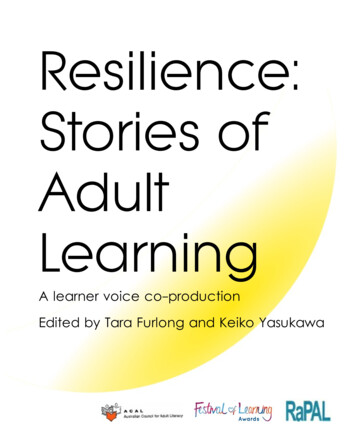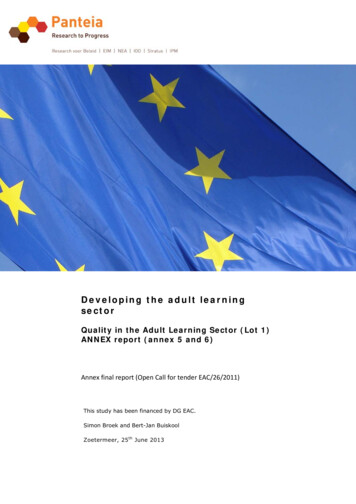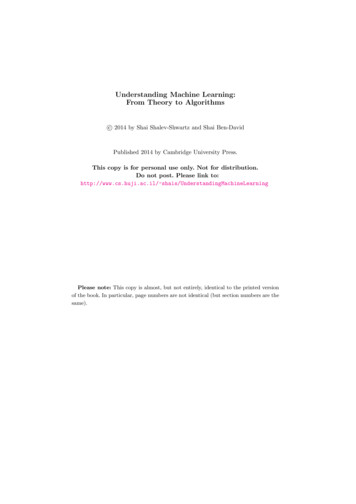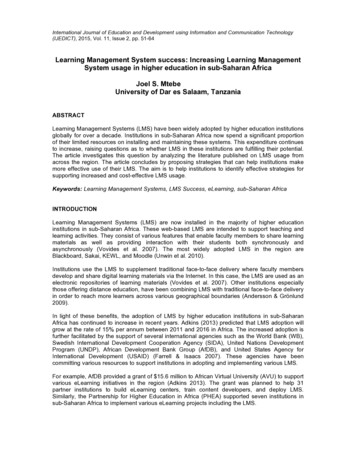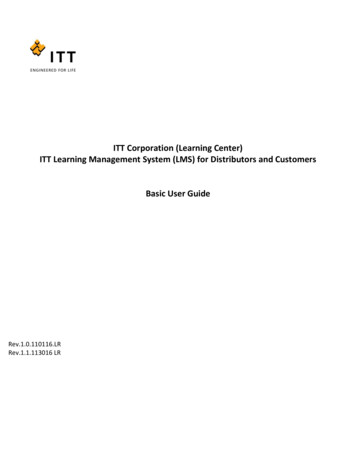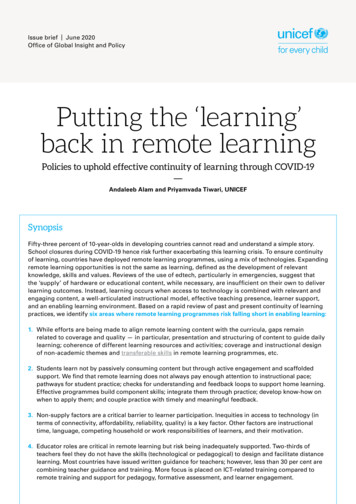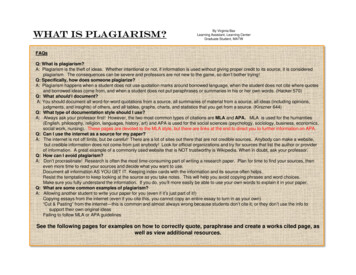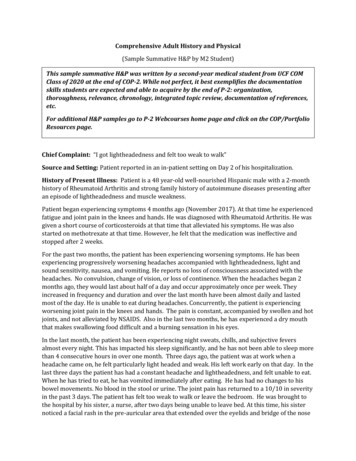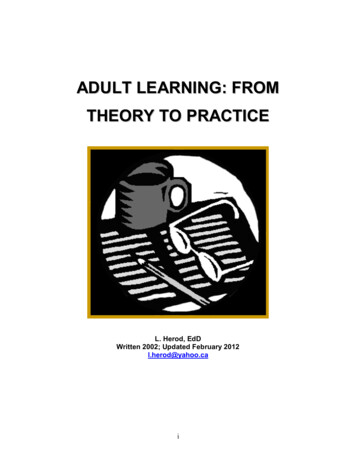
Transcription
ADULT LEARNING: FROMTHEORY TO PRACTICEL. Herod, EdDWritten 2002; Updated February 2012l.herod@yahoo.cai
TABLE OF CONTENTSCOURSE INFORMATION1MODULE 1 – THEORY4Section 1.1: Introduction4Section 1.2: Learning1.2.1: Points to Ponder56Section 1.3: Pedagogy – Andragogy1.3.1: Points to Ponder69Section 1.4: Facilitated Learning1.4.1: Self-directed Learning1.4.2: Transformative Learning1.4.3: Experiential Learning1.4.4: Contextualized Learning1.4.5: Points to Ponder9910121415Section 1.5: Conclusion16Section 1.6: Quiz17MODULE 2 – PRACTICE19Section 2.1: Introduction19Section 2.2: The Adult Learner2.2.1: Characteristics2.2.2: Intellectual Development2.2.3: Motivation and Participation2.2.4: Learning Styles and Multiple Intelligences2.2.5: Points to Ponder202021242630Section 2.3: The Adult Educator2.3.1: Underlying Philosophy of Education2.3.2: Points to Ponder313132ii
Section 2.4: The Curriculum2.4.1: Content2.4.2: Process2.4.3: Points to Ponder33333739Section 2.5: The Learning Environment2.5.1: The Affective Domain2.5.2: Inclusive Learning Environments2.5.3: Points to Ponder39394142Section 2.6: Organizational Factors2.6.1: Points to Ponder4244Section 2.7: Conclusion44Section 2.8: Quiz45MODULE 3 – PUTTING IT ALL TOGETHER47Section 3.1: Teaching and Learning along a Continuum3.1.1: Influencing Factors3.1.2: Pratt’s Model of Direction and Support3.1.3: Taylor’s Model of the Learning Cycle3.1.4: Points to Ponder4747495152Section 3.2: Professional Development3.2.1: Points to Ponder5355Section 3.3: Conclusion55Section 3.4: Quiz57REFERENCES & RECOMMENDED READING59APPENDIXES64Appendix A: Scoring Key for Quizzes64Appendix B: Discussion and Additional ActivitiesModule 1Module 2Module 365657282Appendix C: Glossary87iii
COURSE INFORMATIONCourse DescriptionAdult Learning: From Theory to Practice is an online course intended for tutors inthe Canadian adult literacy community. The course may be used by individuals ina stand alone, self-paced format, and/or by groups in various formats, both onlineand offline.The course focuses on a teaching-learning continuum, one end of which isdirected learning and at the other, facilitated learning. The main point raised anddiscussed throughout the course is that adult learning is highly individualistic andfluid. As such, it requires that tutors be very flexible and utilize a range ofteaching approaches and methods in order to enhance learning.The first module of the course looks at current adult learning theory, while thesecond module covers this theory as it relates to the practice of adult education.A third module blends theory and practice and provides tutors with some ideasfor dealing with the myriad of factors that influence adult learning. The courseincludes “Tips for Tutors,” but it should be recognized that the intent of the courseis to stimulate adult literacy tutors to reflect critically on the notion of a teachinglearning continuum and is not intended as a “how-to” course. An excellentresource for more practical information is Peter Renner’s “The Art of TeachingAdults.”Each module concludes with a multiple choice quiz. These will assist you toassess your grasp of the foundational information contained in each module (i.e.,as discussed in the first section of Module 1, to acquire the basic material andprocess it to a moderate degree). In the online version of the course, the quizzesare interactive in order to provide you with immediate feedback for eachquestion. In the PDF version, the answers are listed in Annex A.There are also sections entitled “Points to Ponder” scattered throughout eachmodule. These are designed to stimulate critical thinking or deeper levelprocessing of the material (as discussed in the first section of Module 1). Thereare no right or wrong answers for these; rather, they are issues each individualeducator must decide upon for him/herself. A discussion of each point is providedto assist you in considering the complexities of the point/issue. In the onlineversion, each point is linked to the discussion, while in the PDF version thediscussions may be found in Annex B. Additional activities for each point havealso been provided.While plain language has been used wherever possible in the course, the termscommonly used by adult educators are included in order to convey the fullmeaning of these adult learning concepts. However, a “Glossary of Terms” has1
been provided in both the online and PDF versions of the course to assist userswith the language. Terms that are included in the glossary are bolded throughoutthe course in both the PDF and online versions.Finally, a comprehensive list of resources, both text and available on the WorldWide Web, has been provided for each of the major concepts in the course.Use of Course MaterialThe material in this course is freely available to any individuals and/or groupswishing to use it for “not-for-profit” certification, professional development and/orgeneral interest purposes. Users are encouraged to adjust the material asrequired to suit their particular learning situation. For example, in that the fielddiffers from location to location, groups may wish to include a module relatingspecifically to adult learning and literacy in their particular region. Some groupsmay wish to include additional material such as foundations of adult education,adult development, and so on. Or, some users may need to reduce the materialsomewhat for a professional development session or introductory workshop.Whatever the case, please feel free to adjust the material as needed, as long asit is “not-for-profit.”Recommendations for UseThe course may be used by either individuals in a stand alone, self-paced format,and/or by groups fully online or in a hybrid format as discussed below. Use by Individual Tutors:o As a Stand-Alone, Self Paced Format - In its most basic form, thecourse may be used by individual tutors in a stand-alone, self-pacedformat. The course offers the convenience of “anywhere, anytime”training in that learners can login to the course site from anywhere andat any time of the day or night. As such, it is suitable for tutors whenattending face-to-face training is difficult in terms of time and/ordistance (e.g., in hard-to-reach rural and Northern areas; withschedules that make face-to-face training hard to fit in). In that thecourse is “stand-alone,” learners may take as much time as they wishto complete the course. It is recommended, however, that learners notbreak for an extended period while taking the course as it is difficult tosustain motivation.o Build in Interactivity - As a stand-alone course, each module endswith an interactive quiz that will allow learners to check theirunderstanding of the information. That said, learning is most effectivewhen there is a degree of interaction with others in that it aids in moredeeply processing information and keeping motivation high. As such, it2
is recommended that wherever possible, individual learners build in adegree of interactivity. Some suggestions for doing so include: Partner with Another Tutor – arrange to work on the coursethe same time as another tutor you know is, so that you candiscuss the material as you go along Arrange for a Mentor – ask a more experienced tutor toguide/support/assess your course work Join an online discussion forum – Check with your regionaladult literacy office to find out if there are any online forums foradult literacy tutors in your province or region.Use by Groupso Online Format Self-paced, Stand Alone, Semi-Supported: The user group setsup mentoring relationships between individual learners andmore experienced tutors. Learners work through the course attheir own pace, but have an experienced tutor they could call onto discuss the material, for guidance and support, etc. Self-paced, Fully Supported – The user group providesmentoring and assesses learning while individual learners workthrough the course at their own pace. Online Group – The user group assigns specific timelines forlearners to take the course online. In addition to providingsupport and guidance, the user group takes on an activeeducative and assessment role. Interactive elements such asan online discussion forum or teleconferencing component arebuilt in.o Hybrid Format (Online and Face-to-face Components): Whileonline interaction during a course is cost-effective and easily managed,a degree of face-to-face interaction can enhance learning. As such, a“hybrid” course (i.e., much of the course is completed online, but adegree of in-class interaction is built in) may be desirable for usergroups to include. The face-to-face meetings could range from just afew to numerous regular meetings throughout the course depending onthe resources and needs of the user group.3
MODULE 1: THEORYContentsSection 1.1: IntroductionSection 1.2: Learning1.2.1: Points to PonderSection 1.3: Pedagogy – Andragogy1.3.1: Points to PonderSection 1.4: Facilitated Learning1.4.1: Self-directed Learning1.4.2: Transformative Learning1.4.3: Experiential Learning1.4.4: Contextualized Learning1.4.5: Points to PonderSection 1.5: ConclusionSection 1.6: QuizSECTION 1.1: INTRODUCTIONThe purpose of this course is to provide adult literacy tutors with informationregarding teaching and learning with adults. The main theme threadedthroughout the course is that teaching and learning are best viewed as acontinuum with pedagogy (directed learning) at one end, and andragogy(facilitated learning) at the other. It is suggested that in order for learning to beeffective, tutors must move along this continuum based on the educationalobjective of the learning activity, as well as a number of other influencing factors.In the interests of keeping the course manageable, detailed information about apedagogical approach and techniques has not been covered directly in that mostof us are familiar with pedagogy through our K-12 education. This is not true ofandragogy or facilitated learning, however, and as such we will explore thetheory and practice of this approach in much more detail.Finally, in that reading about and then actually doing something are often twodifferent things, it is recommended that tutors who are using this course in astand-alone format, especially novice tutors, should try to arrange for theguidance and support of an experienced tutor if at all possible.4
SECTION 1.2: LEARNINGHow might we define learning?For the purposes of this particular course, the most important dimension thatmust be captured in any definition of learning is the depth of processing ofskills/knowledge. This refers to the level at which we are engaged in thinkingabout what is being learned. Jarvis (1992) aptly points out that learning may bedistinguished by that which is non-reflective and that which is reflective. Nonreflective learning demands very little thinking on our part such as when wememorize something or perform a simple task (i.e., we take something in or learna skill in its simplest form without altering it, attaching personal meaning, etc).Reflective learning, on the other hand, requires far more thinking on our part.We understand the ‘why’ of the knowledge/skill, can break it down into itscomponent parts and reassemble it in a new form, and so on. While theemphasis in terms of processing is on the intellectual or cognitive domain, tosome extent processing also involves the physical and/oremotional/psychological (termed “affective”) domains. We will discuss thisfurther under the section, “Multiple Intelligences” and “Learning Styles” in Module2.Non-reflective thinkingReflective thinkingIt is helpful to think of learning in this respect as a continuum rather than as an“either-or” proposition. At one end is non-reflective learning, while at the otherlies reflective learning, with varying degrees in between. Where exactly one ison the learning continuum at any given point in time will depend on numerousfactors (e.g., the curricular material, objectives, learning style), as will bediscussed later in the course. For example, simply memorizing the formula forcalculating percentages and completing some worksheets would involve learningtowards the non-reflective end of the continuum. If, however, we then look atwhat other mathematical operations could be used in lieu of percentages, howcalculating percentage could be combined with other mathematical operations toproduce more complex information, or initiate a discussion about what situationswe would need to be able to calculate percentage, we would move toward the5
reflective end of the continuum. Processing this skill to a deeper level wouldmean that students would be able to explain the process to others, consider andassess alternatives, use the skill/knowledge to decide on a course of action, andso on.Non-reflective learningReflective learning(rote or surface level learning)(deep level processing)Definition of LearningLearning is the cognitive/physical/affective acquisition and processingof skills/ knowledge to varying depths, (where “depth” refers to one’sunderstanding of, ability to manipulate, apply, and/or communicate theskill/knowledge).1.2.1: Points to Ponder (Please turn to Annex B for a discussion of these pointsand additional activities)Reflecting on your own tutoring experiences, have you used an approach thatwas more toward the andragogical end of the continuum? If so, what were youhoping to gain? If not, why?SECTION 1.3: PEDAGOGY - ANDRAGOGYShould similar teaching methods be used across the learning continuum?If we accept that learning is best viewed as a continuum, it stands to reason thatteaching must necessarily follow suit. That is, a range of teaching methods andflexibility is required by educators in order for learning to be effective. As weshall discuss in this section, in the past fifty years the pendulum of adulteducation has swung from a traditional teacher-centred approach through to alearner-centred approach, and is finally coming to rest at a mid-point thatrepresents a much more balanced approach.In the early 1970’s, an educator named Malcolm Knowles proposed that adultslearn differently than do children and used the term “andragogy” to describe hisphilosophy of “the art and science of teaching adults.” As the table belowhighlights, andragogy stood in stark contrast to pedagogy, the traditionalapproach favoured in education at the time.6
Pedagogy (Teacher-centered)Learners are dependentAndragogy (Learner-centered)Learners are independent, self-directedLearners are externally motivated (e.g., byrewards, competition, etc)The learning environment is formal andcharacterized by competitiveness and valuejudgmentsPlanning and assessment is conducted by theteacherTeaching is characterized by transmittaltechniques (e.g., lectures, assignedreadings)Learners are intrinsically motivated (i.e.,interested in learning for learning's sake)The learning environment is more informaland characterized by equality/mutualrespect, and cooperationPlanning and assessment is a collaborativeaffair (i.e., teacher and students)Teaching is characterized by inquiryprojects, experimentation, independentstudyEvaluation is accomplished mainly byexternal methods (e.g., grades, tests &quizzes)Evaluation is characterized by selfassessment(Note: The terms “andragogy” and “pedagogy” can be a mouthful and as such,many adult educators use the terms “directed learning” and “facilitatedlearning” respectively. For the purposes of this course we will use the termsinterchangeably throughout the course.)Directed LearningFacilitated LearningIt is prudent at this point to provide examples of situations involving directed andfacilitated learning. MacKeracher (1996) suggests that directed learning “helpslearners acquire specific skills and knowledge relevant and essential to specifictasks and performance (driving a car, speaking a foreign language, andbecoming a certified plumber)” (p. 218). Another example of a directed learningenvironment would be the military, in particular at novice levels (e.g., recruittraining) in which the teacher is the absolute authority, minimal reflectivethinking is required, and learners have little or no independence. Facilitated7
learning, on the other hand, calls for the educator to “act as a catalyst; providecontent and process resources; serve as a reflective mirror or alter ego; act as aco-inquirer with learners; and, provide support, guidance and encouragement”(MacKeracher, 1996, p. 220). A graduate student conducting a research studyunder the guidance of a faculty member would be an excellent example offacilitated learning towards the farthest end of the continuum (i.e., the student isrequired to hone his/her critical thinking skills, has a collaborative relationshipwith the teacher, and is permitted a high degree of independence).Directed LearningCharacterized by lecturing(“sage on the stage”), drills,memorization, question andanswer, and immediatefeedback. Teacher totallyresponsible for settinglearning objectives andassessing skills /knowledge.Facilitated LearningCharacterized by guideddiscussions, group work,problem-based learning.Teacher and studentsnegotiate learning objectivesto some extent. Assessment acollaborative effort betweenteacher and learners.Characterized by independentprojects, student-directeddiscussions, critical thinking.Teacher acts as resource and“guide on the side.” Studentsset learning objectives withsome guidance from teacher.To return to the issue of andragogical theory, over time Knowles and many otherinfluential educators came to see that describing andragogy as adult learning andpedagogy as teaching related to children was somewhat of a false distinction.Many children do well when a facilitated teaching approach is used. They areresponsible, capable of working collaboratively and constructing (rather thansimply receiving) knowledge. Similarly, some adults prefer the structure of apedagogical classroom and do not fare well in a less directed learningenvironment. So, if age is not really the most accurate way of defining thedifference between these different approaches, what is?One major distinction that may be made between directed and facilitated learningare their objectives. Whereas at the farthest point to one end of the continuumdirected learning seeks to transmit surface knowledge/skills from teacher tostudent, facilitated learning at the other end seeks to facilitate the deeperprocessing of knowledge/skills with the guidance of the teacher. Taylor,Marineau & Fiddler (2000, p. 28) offer the following example of an adult studentwho has been encouraged to reflect more critically on what she is learning:8
I tried reflecting on my learning as it was happening and I becameaware for the first time of some of my blind spots—you know, where Iwasn’t being at all objective about myself or open to someone else’sideas. This has been a huge awakening for me. Because of learning aboutreflection, and learning to do it, I am now willing to listen to anotherperson’s perspective and weigh it; I’m asking others for feedback aboutmyself and I can do more generalizing—I’m not so concrete abouteverything. I just never thought I would have this kind of flexibility.As we shall discuss in the next section, when learning is viewed in terms of acontinuum it not that far a leap to suggest that teaching must follow suit.1.3.1: Points to Ponder (Please turn to Annex B for a discussion of these pointsand additional activities)As we move toward the facilitation end of the continuum, the notion of “learnercentredness” takes on increasing importance. Reflect on your own experienceas a tutor and think of an example of how you have made (or could make) yourenvironment more learner-centred.SECTION 1.4: FACILITATED LEARNINGWhat do teaching and learning look like from an andragogical perspective?In the following sections we will look at four main approaches to facilitatinglearning that are currently guiding adult education. They are presented as distinctor separate types of learning, but like most things in life they overlap to someextent. Taken together, they constitute what we will call “facilitated learning.”1.4.1: Self-Directed LearningIn the 1970’s, Knowles and other educators such as Carl Rogers were beginningto promote the idea of that education needed to move away from being ateacher-centred field in which directed learning was pervasive, towardslearner-centredness or facilitated learning. Supporters of this approachsuggested that education should adjust to the needs and wants of learners ratherthan the other way around. From their perspective, teachers need to move out ofrole of “sage on the stage” to that of “guide on the side” in which learningbecomes more of a collaborative affair between the teacher and student.Students are encouraged to become more involved or self-directing in theirlearning. The notion of self-directed learning is based on a humanist philosophy,the underlying assumption of which is that education should focus on thedevelopment of the individual.9
In self-directed learning, the goal of education becomes more about process(development of critical thinking skills, maturation as a person and citizen) thancontent (acquisition of subject-based knowledge/skills). As Barer-Stein andDraper (1988) suggest:This approach focused on encouraging people to explore the depths oftheir feelings, building self-concept, and valuing human life. The goal wasto maximize human potential, building on the innate goodness of theindividual, with the support of empathetic teachers as facilitators andpartners in learning . This philosophy is especially evident in adulteducation programs today which value learning as a process and whichencourage discussion and self-discovery (p. 61).Thus, from a humanist perspective learners are seen quite differently from thenotion of “empty vessels waiting to be filled with knowledge” held by moretraditional educators. Goldgrab (in Draper & Taylor, 1992, pp. 240-241) capturesthe essence of humanism in the musings of a tutor, “We see learners for whatthey have to give, their ideas as individuals, and for their life experience andcommon sense. It breaks down stereotypes of what a learner is in your mind. “Tips for Tutors: Learning is facilitated when learners can assess their ownlearning needs and select their own learning goals and directions for change.If this is not possible, then learners should have a complete understanding ofthe objectives that have been established by others, should be able toaccept these, and should be willing to commit themselves to the selecteddirection for change. (MacKeracher, 1999, p. 41)As we shall discuss in the next section, the emphasis on personal growth hasbeen and continues to be the subject of some debate in the field of adulteducation.1.4.2: Transformative LearningIn the 1970‘s, Jack Mezirow suggested that the goal of adult educators must beto guide learners to transform; that is, literally to grow and mature intellectuallyand in turn, change as a person through critical reflection on one’sassumptions, beliefs and values. The notion that learning results in varyingdegrees of change is not a problem for most adult educators. That adulteducation should strive to directly effect change at a personal level was asignificant departure from traditional education in which such change was anindirect result of learning.In directed learning then, change relates more to achieving technicalcompetencies or mastering subject matter, and less to a change in one’sperspective. In transformational learning, however, “ learners are encouraged10
to challenge, defend, and explain their beliefs, to assess evidence and reasonsfor these beliefs; and to judge arguments” (Grabove, 1997, p. 91), the ultimategoal of which is personal growth, independence, and independent thinking. AsMezirow (1997, p. 8) writes, “the educator’s responsibility is to help learnersreach their objectives in such a way that they will function as more autonomous,socially responsible thinkers.”Tips for Tutors: Instructors of adults can facilitate transformative learning byencouraging dialogue groups that help build relationships where tension and dissentcan be explored safely. Teachers can also work to prepare themselves to teach froma transformative perspective through critical self-examination as well as sensitivityto others. (S. Scott, in Barer-Stein & Kompf, 2001 p. 245)There has been and continues to be considerable debate among educatorsregarding the ethical implications of deliberately setting out to effect personalchange in learners. But what if learners don’t want to grow?Lawrence Daloz, an adult educator in the United States, wrote about just such astudent in “The Story of Gladys Who Refused to Grow.” Daloz acted as a mentorand academic advisor to a woman named Gladys, a woman in her 60’s who hadreturned to college to get a diploma after raising a family and running a businessfor most of her life. For the most part Gladys did well and was content with hercourse work, but she did not deal well with any requirement to think criticallyabout her own beliefs and values, to identify her assumptions and challengethem. Gladys just wanted to finish her program and write a book about herexperiences with running a business. She was not at all interested in reflectingon the meaning of these experiences, she simply wanted to recount them.Believing his role to be going beyond simply assisting Gladys with her courses,Daloz is baffled by her unwillingness to develop her critical thinking skills.However, he then has the opportunity to meet her family and he begins to seethat her life extends well beyond her education. Her unwillingness to changerelates to her relationships which would be threatened if she were to “transform”or grow:.change demands a complex kind of renegotiation of relationships amongspouses, children, friends, parents, and teachers Sometimes it is justplain simpler to stay right where they are, or at least to appear that way.That seems to be what Gladys chose to do (Daloz, p. 7).Daloz chooses to set aside his “teacherly narcissism” and leave Gladys bealthough he continues to be bothered by the question of whether he actuallyfailed her in the end.Are our adult literacy students affected similarly by learning? As cited in Merriamand Caferella (1999), Fingeret investigated the relationships of low literacy adultsand found that they developed extensive interpersonal relationships based on an11
exchange of goods and services that related to the individual’s illiteracy. Forexample, in exchange for reading or writing something, the learner might babysitfor the person helping him/her out with this. However, no longer needing toexchange babysitting for assistance with reading and writing tasks obviouslychanges the relationship. As Fingeret suggests, learning which decreases alearner’s dependence on others can have the unintended result of isolating thelearner from important sources of support.Most educators agree that Mezirow’s notion of transformational learning hasmade an important contribution to adult education by drawing attention to thebenefits of fostering critical thinking skills. Whether or not personal growthshould be a direct goal or an indirect consequence of learning, however, remainsa bone of contention in the field.1.4.3: Experiential LearningIn the mid 1980's, David Kolb proposed that adult learning is more effective (i.e.,processed at much deeper levels) when learners are more directly involvedrather passively receiving knowledge transmitted by teachers.Kolb developed what he called the “experiential learning cycle” in which thereare four distinct stages of learning. While the cycle can start at any stage, allstages are required in order for students to learn effectively: Concrete Experience - active learning as opposed to passive receipt ofknowledge (i.e., learn about something directly by being involved with thematerial rather than learning about it) Reflective Observation – refers to thinking critically about the experience. Abstract Conceptualization – linking the experience to the theory orconcepts underlying it. Active Experimentation – testing out one’s learning in new situations.Taylor et al (2000, p. 24) offer the following example of a student who was ableto transfer Kolb’s model to his employment as a police officer:In my most recent report about traffic conditions on a local street, I notonly presented the facts about the collisions and enforcement activities,but I reflected on the previous attempts to solve the problem as well as theeffects of those attempts. Having the ability now to generalize about thesituation and the trends in traffic safety, I was able to identify new ideasand solutions to try and use to try and increase the level of traffic safety onthis street. This process also allowed me to predict possible results, thuscreating a sort of method of evaluation for further analysis in the future.12
Experiential learning has come to be known as “learning by doing” or “hands-onlearning.” This doesn’t convey its complexity, however, in that this type oflearning goes far beyond simply being more active physically. Rather, it is amatter of being more engaged in one’s learning cognitively; that is, deep levelprocessing of knowledge/skills through experience, reflection, experimentationand application.A key notion which experiential learning has served to highlight is of formallearning (e.g., a university course) and informal learning (e.g., everyday life),As Bouchard (in Barer-Stein & Kompf, 2001) writes, “Experiential learningchallenges the misconception that learning mostly occurs in formal environmentssuch as classrooms, and replaces it with the notion that all learning is the resultof experience, no matter where it occurs” (p. 177). This is particularly relevant toadult literacy learners in that typically, they prize formal education andundervalue the informal learning gai
directed learning and at the other, facilitated learning. The main point raised and discussed throughout the course is that adult learning is highly individualistic and fluid. As such, it requires that tutors be very flexible and utilize a range of teaching approaches a
